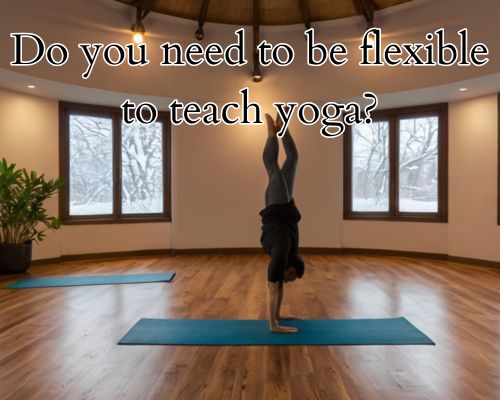
Do You Need to Be Flexible to Teach Yoga?
Yoga has become a popular practice in Mornington, Australia, offering both physical and mental benefits. Whether you’re looking to deepen your own practice or share the gift of yoga with others, the question often arises: Do you need to be flexible to teach yoga? The answer is both simple and complex, depending on perspective, experience, and the goals of your yoga journey.

This article explores this question and provides insights into the flexibility required to teach yoga, focusing on the role of personal practice, teaching styles, and the broader aspects of yoga that go beyond physical flexibility. With local references to Mornington, Australia, we’ll also discuss how community and accessibility shape the yoga landscape in this beautiful coastal town.
Understanding Flexibility in Yoga
In yoga, flexibility is typically associated with the ability to bend and stretch the body into various poses. Many people assume that one must be flexible to practice yoga, let alone teach it. However, flexibility in yoga is about much more than just the physical ability to reach for your toes or bend deeply into a pose.
Yoga’s holistic approach involves not only physical flexibility but also mental and emotional flexibility. The true essence of yoga is about finding balance, mindfulness, and connection—whether to your own body, your breath, or your community. Thus, flexibility in teaching yoga is more about being adaptable, patient, and present for your students, rather than performing advanced poses with ease.
Personal Flexibility vs. Teaching Flexibility
One of the most common misconceptions about becoming a yoga teacher is that you need to be extremely flexible yourself. While personal flexibility can be beneficial in teaching certain poses, it is not a requirement. Yoga teachers come in all shapes, sizes, and flexibility levels, and each one brings a unique set of skills to the table.
In Mornington, as in many places around Australia, yoga classes are designed to accommodate all levels of students, from beginners to seasoned practitioners. A teacher’s role is to guide students through their own practice, offering modifications and adjustments to ensure safety and inclusivity. A teacher who is highly flexible may demonstrate advanced poses with ease, but their ability to teach effectively lies in their understanding of the practice, communication skills, and empathy toward their students. Visit website for more.
The Importance of Communication and Instructional Skills
Teaching yoga is more about effective communication and the ability to break down complex movements into understandable instructions than it is about demonstrating advanced flexibility. Whether you’re leading a gentle flow or an intense vinyasa class, the key to being a successful yoga teacher lies in your ability to help your students connect to their bodies and their breath.
In Mornington, many yoga teachers emphasize the importance of clear, concise instructions and the use of props to make yoga accessible to everyone. It’s not just about the poses; it’s about fostering an environment of inclusivity where all students feel supported, regardless of their flexibility or experience level.
Mental and Emotional Flexibility in Teaching Yoga
While physical flexibility may not be required to teach yoga, mental and emotional flexibility is an essential skill for any teacher. Yoga is about more than just physical movement; it is about cultivating awareness and presence. Teachers need to be flexible in their approach to meet the individual needs of their students, whether that means modifying a sequence for a student with an injury or adapting the pace of the class for those new to yoga.
In Mornington, a growing yoga community has embraced the idea that yoga is for everyone, regardless of age, size, or level of flexibility. Teachers here are trained to modify poses and create safe spaces for students to explore their practice without judgment. This means that while you may not be able to perform every advanced pose, your ability to empathize with your students and offer modifications will be just as valuable. Visit website for more.
Yoga Teaching Styles: The Role of Flexibility
There are many different styles of yoga, and each has its own focus. Some styles, such as Ashtanga and Iyengar yoga, may place more emphasis on achieving specific postures and may require a higher degree of flexibility. However, other styles, such as Hatha, Restorative, or Yin yoga, focus on slower movements, alignment, and relaxation, which can be more accessible for teachers and students with limited flexibility.
In Mornington, you’ll find a variety of yoga styles offered at local studios. From energetic Vinyasa flows to restorative practices designed for deep relaxation, yoga teachers in the area bring a wealth of experience and creativity to their classes. The beauty of teaching yoga is that you don’t have to conform to one style or standard; instead, you can find the teaching method that aligns with your personality and your students’ needs.
Developing Your Own Yoga Practice
While you don’t need to be highly flexible to teach yoga, having a personal practice is important for understanding the principles of yoga and cultivating a deeper connection to your body. A personal practice allows you to experience the challenges and benefits of yoga first-hand, which ultimately makes you a better teacher. It’s about developing your own awareness of your body and breath, which will help you guide others more effectively.
In Mornington, many local teachers encourage new instructors to take regular classes themselves, whether they are teaching or not. The community here is supportive, and yoga studios offer workshops and mentorship programs for aspiring teachers. Being flexible in your approach to your own practice—understanding your body’s limitations and celebrating its strengths—is part of what makes a great teacher.
Flexibility in Yoga and Community Support
In Mornington, yoga is more than just a physical practice—it’s a community. The town’s beautiful natural surroundings, including its beaches and parks, make it a perfect place for yoga practice. Many studios offer outdoor yoga classes, allowing teachers and students to connect with nature while practicing mindfulness. The welcoming yoga community in Mornington embraces people of all abilities, helping to break down barriers that might otherwise discourage people from starting or continuing their practice.
The focus on inclusivity and accessibility in Mornington’s yoga community means that you don’t have to be highly flexible to become a teacher. Whether you’re new to yoga or a seasoned practitioner, the local studios and instructors offer a wealth of resources, training, and support for teachers at all stages of their journey.
Conclusion
So, do you need to be flexible to teach yoga? The short answer is no. While physical flexibility may enhance your practice and teaching, it is by no means a requirement. The true essence of yoga teaching lies in your ability to communicate, empathize, and adapt to the needs of your students. Whether you’re teaching a challenging flow or guiding a restorative class, the most important qualities for a yoga teacher are patience, mindfulness, and the ability to create a supportive and inclusive environment.
In Mornington, Australia, a vibrant and diverse yoga community exists where flexibility is defined in many ways. Whether you’re looking to teach or practice yoga, remember that yoga is for every body—regardless of how flexible you are. Embrace the journey, stay adaptable, and share the transformative power of yoga with those around you.

